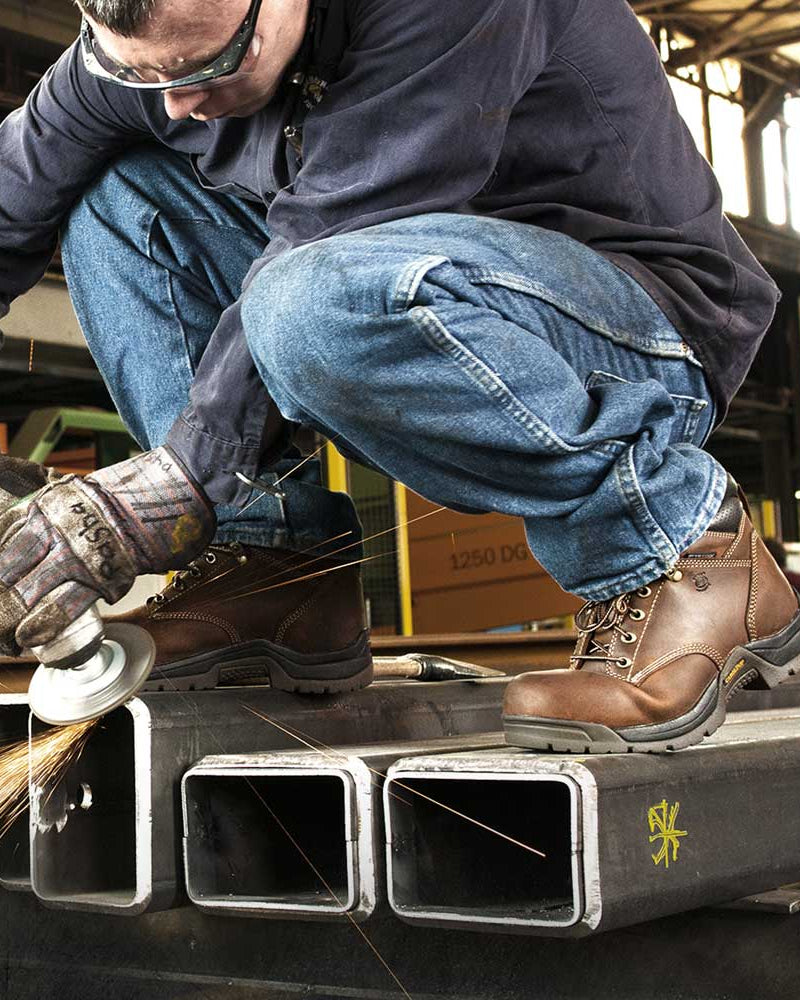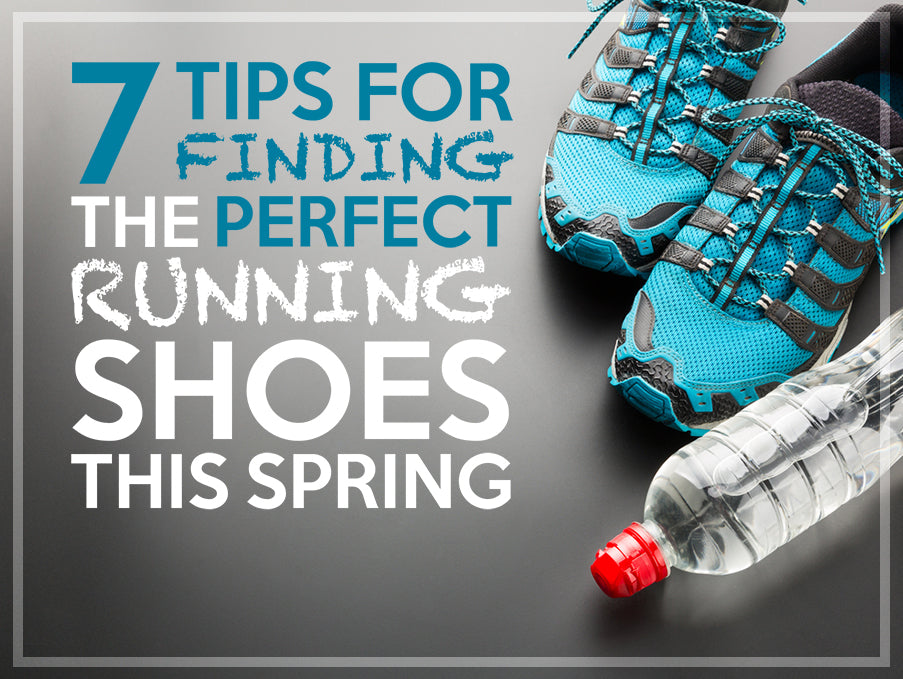 Finding the right running shoe is just as important as a carefully researched fitness plan to help meet your goals. Unfortunately, many people are familiar with the pain and regret that comes from choosing the wrong pair of shoes for your activity of choice. This can especially true when it comes to an active pastime like running.
Finding the right running shoe is just as important as a carefully researched fitness plan to help meet your goals. Unfortunately, many people are familiar with the pain and regret that comes from choosing the wrong pair of shoes for your activity of choice. This can especially true when it comes to an active pastime like running.
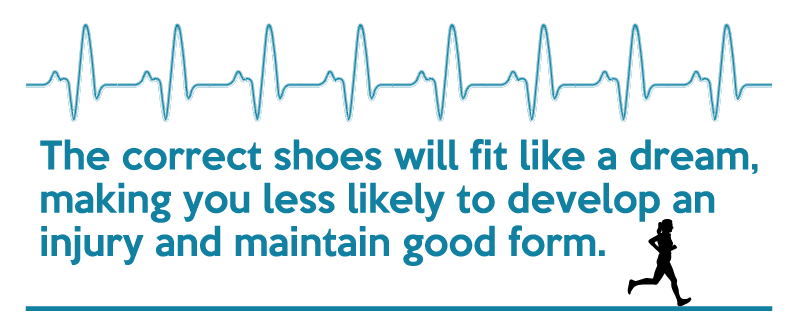
Despite the challenges, exercise should be enjoyable, and the right shoes can make sure that it is. The correct shoes will fit like a dream, making you less likely to develop an injury and maintain good form. They'll also provide ideal support for running, helping you get more out of your workouts.
However, knowing you want to get your spring workout routine off to a good start with the correct pair of running shoes is one thing. Let's go through a list of considerations to help find the perfect fit for you. You won't believe the positive impact the right choice will have on your fitness goals.

Take your fitness level and running goals into consideration.
Walk into any athletic shoe store and ask a footwear expert to help you choose a pair of running shoes, and you're likely be met with the same two questions. First, you'll be asked whether you're training for something specific, like a marathon. Next, you'll be asked about the amount of distance you'll be running every month.

Of course, not everyone is training for a career in sports or dreams of taking first in the Boston Marathon. Most of us are really just trying to live our best lives by getting in shape and staying that way. Chances are you're the latter, but it's important to understand that your choice in running shoes still matters.
Are you brand new to running? You're probably still figuring out your form, so go with a shoe designed to protect your feet from injury during that process. Are you running between 10 and 20 miles a week? You're a low-mileage runner. Someone who's running between 20 and 40 miles per week would be considered a medium-mileage runner. Finally, logging more than 40 miles per week qualifies you as a high-mileage runner.
Where you fall on that scale will determine your needs when it comes to factors like cushioning, performance, durability, and stability. Runners that cover great distances (or plan to, eventually) should opt for shoes with more cushioning for shock absorption, as well as shoes that are designed to stand up to heavy, long-term use.

Consider any past injuries, as well as the way they affect your performance.
Injuries sustained while running or working out can be tricky. They can happen to anyone, and almost always does, sooner or later. Sometimes recovering from a running injury is as simple as staying off your feet until you've healed, and then getting back to it. Other times, injuries can mean ongoing issues that can permanently affect the way you run.
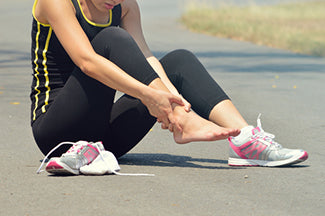 That said, ask yourself two questions before definitively deciding on any particular pair of shoes. Are you currently injured or recovering from an injury? Also, do you have a history of injuries? If you experience ongoing issues with very similar injuries, it's possible that your current running shoes are related to the issue in some way--something many people fail to even consider. This should be kept in mind during the shopping process.
That said, ask yourself two questions before definitively deciding on any particular pair of shoes. Are you currently injured or recovering from an injury? Also, do you have a history of injuries? If you experience ongoing issues with very similar injuries, it's possible that your current running shoes are related to the issue in some way--something many people fail to even consider. This should be kept in mind during the shopping process.
If you're currently recovering from an injury, go for a running shoe that will help protect your foot and ankles during the process. Look for features like additional cushioning to help absorb shock and sturdy structures designed to properly support feet during activity. We especially love options like this design from Brooks. As you heal, you can gradually work your way back to the lighter, more flexible shoes many runners prefer.
Even if you've formerly been injured and have healed, it's best to err on the side of caution. It's easier to aggravate an old injury than many people think!

Gain a better understanding of your running gait.
Ask any seasoned expert what's really important to picking the right shoe, and they'll talk about the importance of knowing your gait and running style. Running is an activity that only starts with your feet. If you're not in alignment with your upper and lower body, every single step you take is a new opportunity to hurt yourself. The right shoe can work wonders when it comes to getting your feet properly aligned. It can also help you get more out of your training sessions, overall.
 If you have no idea what your gait type is, there are a couple of ways you can find out. Many sporting goods stores have salespeople on staff who have been trained to observe the way you walk or run, identify your gait style, and recommend a shoe based on what they see. You can also ask your podiatrist to do the same. However, you may be able to determine your style for yourself. Most gaits fall into three standard categories:
If you have no idea what your gait type is, there are a couple of ways you can find out. Many sporting goods stores have salespeople on staff who have been trained to observe the way you walk or run, identify your gait style, and recommend a shoe based on what they see. You can also ask your podiatrist to do the same. However, you may be able to determine your style for yourself. Most gaits fall into three standard categories:
-
Neutral: If you have a neutral gait, your ankles, knees, and hips are all in alignment when you walk or run. Also, your arch only flexes a little when you're in motion.
-
Overpronated: If this is your gait, your foot tends to roll too far inward as you walk or run. You should purchase a shoe with a motion control feature, as well as maximum support.
-
Underpronated: If your gait is like this, your foot has a tendency to roll outward when you walk. Choose a running shoe that features more cushioning.
The best way to tell which of the above is closest to your gait style is to take a good look at the wear patterns on your current shoes. People with overpronated gaits have shoes that show wear along the inside edge of the shoe, while those with an underpronated gait will have shoes with wear on the outer edge instead. If the wear on your shoes is relatively even, you probably have a neutral gait.

Keep in mind that your toes need more space than you might think.
Think back to what shoe shopping with your parents was like as a kid. For many of us, your mom and dad would be adamant about checking to make sure the pair you were getting left plenty of "room to grow" up front in the toe box. It's still good advice: choose shoes that have ample room for your feet.
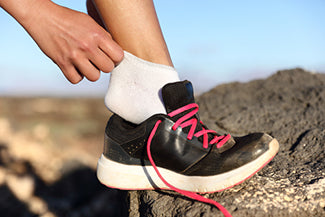 One of the more common reasons for foot pain or discomfort associated with running is a shoe that's way too small. In fact, it's estimated that up to 90% of people aren't wearing a large enough size. When you run, your feet naturally swell and expand. The right size shoe will leave enough room to accommodate that process.
One of the more common reasons for foot pain or discomfort associated with running is a shoe that's way too small. In fact, it's estimated that up to 90% of people aren't wearing a large enough size. When you run, your feet naturally swell and expand. The right size shoe will leave enough room to accommodate that process.
If your current shoe ever makes you feel like your toes or feet are restricted by your shoes in any way, you might be wearing too small a size. The right pair of running shoes will leave a full thumbnail's worth of empty space at the front of the toe box the very first time you try them on.
Don't simply assume your shoe size, either. If you've never had your feet measured (or it's been awhile since the last time), start the shopping process there. You'll want to consider whether or not shoes from a particular manufacturer tend to run big or small, as well.

Plan on working your new shoes into your routine gradually.
Even though running shoes are designed to be comfortable almost by definition, it's still a good idea to plan on breaking them in a little at a time. It's the best way to spare yourself from any unnecessary foot pain or discomfort. You'll be less likely to wind up with complaints like blisters.
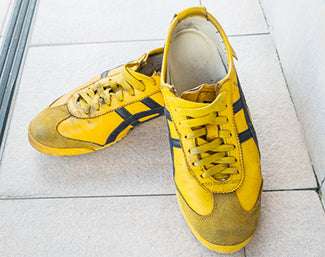 That said, don't wait until your current running shoes are ready to fall apart any day to buy a new pair. Instead, plan on keeping your older shoes in rotation for awhile. Start off by wearing your new pair for about 20-30% of your weekly running distance. As your newer shoes become softer and more comfortable, gradually increase that amount of mileage until you've successfully phased out your older pair.
That said, don't wait until your current running shoes are ready to fall apart any day to buy a new pair. Instead, plan on keeping your older shoes in rotation for awhile. Start off by wearing your new pair for about 20-30% of your weekly running distance. As your newer shoes become softer and more comfortable, gradually increase that amount of mileage until you've successfully phased out your older pair.

Pay attention to the functional parts of the shoe.
Most people tend to get distracted by the colorful upper part of their running shoes while forgetting to pay attention to the shoe's structure. Of course, the upper is important, but it's really only responsible for keeping your foot inside the shoe.
When assessing the practicality of a given option, focus your attention on the bottom portion, instead. That's where the primary structure responsible for supporting your foot and cushioning you against impact shock will be located. You'll also want to make sure you're paying enough attention to the soles.
 Do you like to run outdoors? Look for an option like this pair from Hoka One One Clifton 3 with slip-proof traction that will help you keep your footing even if it gets damp out. Are you more of a treadmill person? Go for something flexible that will be comfortable for indoor workouts, instead.
Do you like to run outdoors? Look for an option like this pair from Hoka One One Clifton 3 with slip-proof traction that will help you keep your footing even if it gets damp out. Are you more of a treadmill person? Go for something flexible that will be comfortable for indoor workouts, instead.
Going forward, you should also learn to monitor the bottom portions of your shoe for signs of damage. The midsole is especially important. If you ever notice features like wrinkles and cracks starting to form, it's probably about time to trade those kicks in for a newer pair. Keep an eye on the tread for wear and tear to get the most from your running shoe.

Make sure the pair you choose truly feels good.
 Your running shoes need to fit properly to be supportive and capable of absorbing impact shock. Look for options that is tailored to your foot, in terms of size, performance, and gait. There's no universal option out there that is automatically going to be the best shoe for everyone. Invest in the time for try on quite a few pairs before finding the right one.
Your running shoes need to fit properly to be supportive and capable of absorbing impact shock. Look for options that is tailored to your foot, in terms of size, performance, and gait. There's no universal option out there that is automatically going to be the best shoe for everyone. Invest in the time for try on quite a few pairs before finding the right one.
Some runners absolutely love the feeling of the ground beneath their feet when they're out there in the zone. Others would rather float above it. Keep in mind that these are shoes you're going to be spending a lot of time wearing if you're serious about running. It's important to choosing a pleasing fit to help keep your fitness goals on track.
Is it time for a new pair of shoes?
If you're like a lot of people, you don't replace your running shoes often enough. The average pair needs to be replaced every 400-500 miles or so. If you run regularly, that's probably about every 3-4 months. However, it's also probably time to replace your shoes if:
-
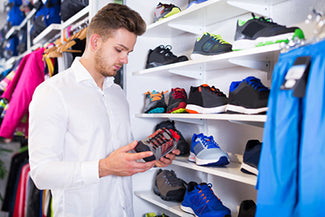 Any part of the shoe is falling apart or showing visible signs of serious wear and tear.
Any part of the shoe is falling apart or showing visible signs of serious wear and tear.
-
Your shoes used to be really comfortable, but now feel less so, seemingly for no reason.
-
Your shoes no longer feel as supportive as they used to be.
-
Your feet have changed recently in a way that might mean your shoes are no longer the right size for you (i.e., injury or pregnancy).
Start your search for the perfect pair of kicks when you browse our extensive collection of fantastic running shoes for women, men, and children. Choose from the hottest brands, enjoy access to the latest styles, and more. The perfect match for your spring running goals may be only a few clicks away!

